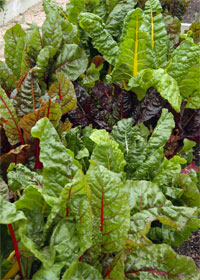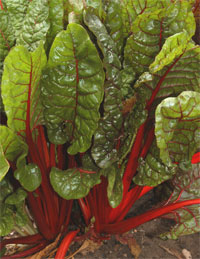Plant of the Month – November, 2011

Beautiful red-ribbed Swiss chard is a winter-time “must” in containers beside the writer’s side door. Photo by Carolyn Skei.
Swiss Chard

Just one back-lit chard leaf is "eye candy." Photo by Carolyn Skei.

Chard varieties in a rainbow of stem and leaf colors. Photo by Neil Sperry.

Harvest chard a few leaves at a time by cutting the bright stems near the base. Photo by Neil Sperry.
On a frosty but sunny wintry morning last year, I wandered into my side yard to be greeted by the beautiful back-lit leaves of red Swiss chard. It was a feast for the eyes -– what one of my artsy friends would call “eye candy.” The light coming through those beautiful veined leaves was as dazzling as the lights on the Christmas tree inside.
No wonder Swiss chard has become one of my favorite cool-weather ornamentals as well as a favorite fresh-from-the-garden edible vegetable. I’m not a big vegetable gardener (I love my trees and shade too much), but easy-to-find Swiss chard grows happily in containers this season of the year, and I harvest it a few leaves at a time. The red-ribbed and yellow-ribbed varieties, especially, can brighten any winter landscape. Just one Swiss chard plant can be the “thriller” when you’re putting together a “thriller-filler-spiller” combination in a pot beside the patio door (or any door).
My Swiss chard usually grows no more than a couple of feet high, given that I provide it with no special care beyond routine watering and fertilization. But it can reach stunning proportions where folks grow it for beauty alone (e.g., the Dallas Arboretum and Fort Worth Botanic Garden).
Mother Earth News calls the brightly colored chard varieties the “queens of the edible ornamentals,” and the Bonnie Plants website terms it “the single most glamorous garden green.” But don’t let all that beauty fool you. Swiss chard is as healthful a veggie as you’d want to meet. In recent analyses of nutrient-rich vegetables, it comes in second only to spinach.
Chard is loaded with just about everything that’s good for you, whether you need to protect your heart, control your sugars, or build your bones. Literally, it has everything from A to Z (vitamin A to zeaxanthin, an antioxidant). Check on-line to find just how rich it is in things like minerals, vegetable protein and fiber!
The mildly flavored leaves can be sautéed, steamed or boiled. Add some zip with anything you like: olive oil, butter, lemon juice, garlic, crushed red pepper, feta cheese. It’s good for any meal, but when you anticipate that you won’t be able to “eat right” in this season of over-indulgence, it’s great with eggs for breakfast. Some folks discard the slower-cooking stems, but you’ll find plenty of recipes for those, too. (Bake the stems for a while, then toss the leaves in later, for example.)
Interesting fact: Swiss chard isn’t actually native to Switzerland. It came from the Mediterranean region, and Aristotle wrote about it in the fourth century B.C. I love the fact that we, in our 21st century gardens, are still celebrating it as a special, beautiful gift of the season!
About the author: Carolyn Skei is the editor of Neil Sperry’s GARDENS magazine and e-gardens newsletter and a Collin County Master Gardener.
